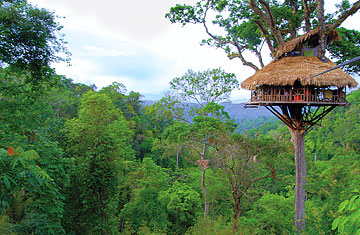
Don't look down Treetop accommodation at the Gibbon Experience
If the Swiss family Robinson were beamed down to northern Laos, they might have come up with something like the Gibbon Experience. This cluster of tree houses is the setting for a remarkable eco-adventure in which guests live and sleep high in the jungle canopy, and spend the days searching for the elusive black crested gibbon, Nomascus concolor lu, using a network of zip lines to speed from tree to tree.
The project began in 2004 in response to poaching, logging and destructive farming practices that wreaked havoc on the surrounding Bokeo Nature Reserve and its most precious inhabitant — rediscovered in the area in 1997 after wildlife officials had for decades deemed it an extinct species. The result is an experience that combines the adrenaline rush of gliding through the sky with the quiet awe of watching gibbons swing between branches hundreds of feet in the air.
From the tourist hub of Luang Prabang, the isolated outpost of Huay Xai on the Mekong River is a full day's drive. (It's closer from the Thai city of Chiang Mai — just a half day away.) At Huay Xai, you'll board a bumpy shuttle bus for a three-hour journey, then disembark for an hour-long trek to the Gibbon Experience's forest enclave. Do some background reading beforehand because the local guides, from indigenous minorities, are friendly but don't speak enough English to answer detailed questions about the forest and its denizens. Be warned, also, that food and accommodation are very basic. But being serenaded by the animals of the jungle, as you gaze out from your lofty perch at Bokeo's vast green expanses, makes any discomfort worth it.
A three-day, two-night Gibbon Experience costs around $240 a person. See gibbonexperience.org.
